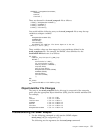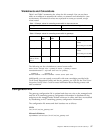
Chapter 8. IBM Tivoli Enterprise Console Gateways
Although not an adapter, the IBM Tivoli Enterprise Console gateway is similar in
that it is software that uses the TME interface of Tivoli Event Integration Facility to
communicate with the event server. Like an adapter, it can be configured with a
configuration file, and the configuration file can be distributed with an adapter
configuration profile (ACP) entry using the Adapter Configuration Facility (ACF).
The IBM Tivoli Enterprise Console gateway and all of the necessary adapter files
for each endpoint operating system are installed on the managed node when the
ACF is installed on the managed node. The ACF is required to be installed on the
same managed node as the Tivoli Management Framework gateway so adapters
and adapter-related files can be distributed to endpoints. Therefore, it is important
to install the ACF on every managed node that is configured as a Tivoli
Management Framework gateway throughout a Tivoli management region.
Note: To distribute a modified IBM Tivoli Enterprise Console gateway ACP to a
managed node with an IBM Tivoli Enterprise Console gateway installed, the
managed node must also have an endpoint installed on it. When you
distribute the profile, the subscriber must be the endpoint on that managed
node.
See “How Events Get Sent to the Event Server” on page 1 for an overview of the
IBM Tivoli Enterprise Console gateway, referred to in the rest of this chapter as the
gateway.
Controlling Event Traffic at the Gateway
At certain times, the number of events coming from endpoint adapters can
overwhelm the gateway, the event server, and even the network. With the gateway
configuration file, you can control the number of events sent across the network.
Thus, you can control the amount of event traffic in your environment.
You control the number of events sent from the gateway to the event server with
the EventSendThreshold, BufferFlushRate, and MaxGWCacheSizeMegs
keywords. To control the number of events sent from the adapter, see “Event
Filtering” on page 14.
Example
To improve the event server performance, the following steps exemplify how to
determine the values for the BufferFlushRate and EventSendThreshold keywords
for the gateway.
The values provided in this example can vary greatly from installation to
installation, depending on how many events, adapters, and gateways are in a
particular environment. Use the worksheets provided in “Worksheets and
Calculations” on page 97 to collect and calculate the data for your environment. All
numerical values are expressed in events per second, except where noted.
1. Determine the average number of events that the event server can process.
The example event server, on average, processes approximately 120 events per
second without degrading its performance.
© Copyright IBM Corp. 2002 95


















